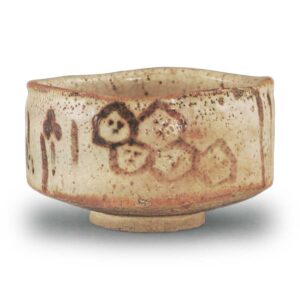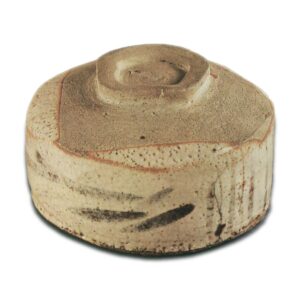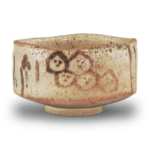

Height: 7.6-8.1cm
Diameter: 12.8-13.6cm
Outer diameter of foot: 6.2-6.9cm
Height of foot: 0.8-1.0cm
This tea bowl has a neat, elegant and bright appearance. It is named after the hexagonal pattern at the center of the design, and there is no other special signature. First, from the waist to the bottom, the surface is flat and straight, but the unglazed area is made into a large triangle, and the clay used there is the same soft mugwort clay, but it is much whiter than other Shino, and it has a slightly rough, dry appearance.
The foot ring is a gentle foot ring, and the five-petal elegant flower shape is similar to a Japanese plum flower.
It was probably shaped while it was still soft and then smoothed out with the fingertips. The overall shaping is very careful, both on the potter’s wheel and in the finishing, and it does not seek to make a big change by showing the footwork too obviously. As a Shino tea bowl, it has a well-shaped, correct form with few lines. For that reason, it is not very varied in shape, but it is of a high quality.
From the flat, stretched waist, the rise is sharp and vertical, and the back is not that high, so the exterior looks rather flat. However, the interior is wider and richer than you might imagine, and it does not feel shallow. The most attractive aspect of this teacup in terms of form is the subtle changes in the rim. The rim is slightly bulging outwards, while the lip is tightly sealed, and the gradual change in the rim into a wavy shape, combined with the beautiful red color, is truly exquisite.
In addition, the glaze is a milky white and is bright and clear. The glaze is evenly applied and there is no unevenness, as it has been melted in the kiln to the right consistency. And, as expected, the bright red color of the fire is effectively expressed in the thin areas of the glaze.
The design is centered around a hexagonal pattern, with iris patterns on either side, and several lines of thin cursive script within what appear to be calendar patterns. The wind-swept appearance of the bamboo leaves on the reverse side is all drawn simply with an uncomplicated touch. There is almost no blank space here, and the design is almost entirely covered with patterns, but the changes in design are well coordinated, and the result is neither forced nor overdone. In particular, the shades of the purple-red and blackish-brown colors of the fire glaze are pleasing, and this gives the whole piece a warm, rich feeling.
In contrast to this colorful exterior, the interior is a single clear white glaze. Moreover, the interior is rich and spacious, and the part called the “mirror” at the bottom is also large and concave. This richness and spaciousness of the interior is considered to be an important element for a tea bowl to be called a “great bowl”, and is a point that can be emphasized especially in Shino great bowls.
According to Arakawa Yuzo, this type of tea bowl is thought to have been made at the Muta-do kiln in Okaya, which is said to have produced the most famous pieces.
The origin of this tea bowl is unknown, but it was formerly in the possession of the Fujita family (Kousetsusai), and after being sold at auction, it passed from one owner to another, and is now in the possession of a certain family in Wakayama Prefecture.
There are no accessories to mention.








